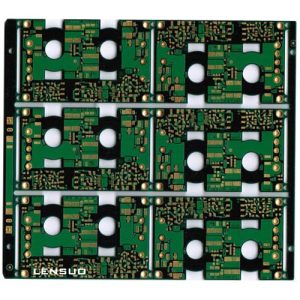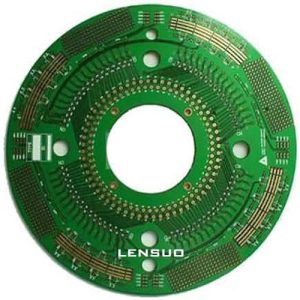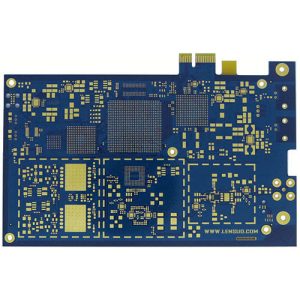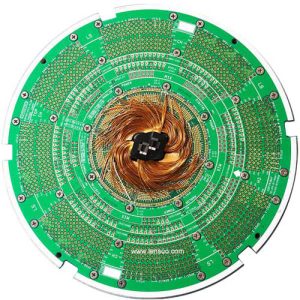Description
Cars have entered the driverless exploration stage, which can actively protect the car driving safety of advanced driver assistance system (ADAS) technology is also being gradually improved. ADAS allows the car to have a perception system, can feel the changes in the environment, and respond at any time. This requires ADAS to use the various sensors in the car to collect the state of the environment around the car when driving, such as static, dynamic object recognition, etc., and then carry out systematic computing and analysis after collection, so that drivers can accurately prejudge the impending danger, thus ensuring driving safety. mmWave Radar PCB

There are many types of ADAS sensors, including cameras, ultrasonic sensors, LIDAR, millimeter-wave radar, etc. The first three types are all susceptible to damage. The first three kinds are easily affected by bad weather (rain and fog, etc.) and lead to performance degradation, or even failure, more or less there are "fatal" defects! But millimeter wave radar is different, it can penetrate dust and fog, rain and snow, is not affected by bad weather and other advantages, and can "24 hours a day, all the time" work, has become one of the core sensors indispensable to automotive ADAS.
Millimeter wave refers to the wavelength of electromagnetic waves in 1-10mm, its bandwidth, high resolution, small antenna component size, can adapt to harsh environments. Millimeter-wave radar for automotive use usually adopts the FM continuous wave radar system with a simple structure and low cost, which is suitable for close-range detection. Millimeter-wave radar compared to centimeter-wave radar is characterized by small size, easy integration, and high spatial resolution. The operating frequencies of automotive millimeter-wave radar are generally 24GHz and 77GHz.
Millimeter wave radar consists of an MMIC chip and antenna PCB board, mainly including an antenna, transceiver module, and signal processing module.
According to the theory of wave propagation, the higher the frequency, the shorter the wavelength, the higher the resolution, and the stronger the penetration ability, so compared with other microwaves, a millimeter wave has a high resolution, good pointing, strong anti-jamming ability, and good detection performance. Compared with infrared, millimeter wave has small atmospheric attenuation, better penetration of smoke and dust, and is less affected by weather. These qualities determine the millimeter-wave radar has all-day, all-weather working ability. Automotive millimeter wave radar is mainly concentrated in the 24GHz and 77GHz frequency bands: 24GHz radar is mainly to realize the near-range and mid-range detection, which can be used for automotive blind spot monitoring, lane departure warning, parking assistance, etc. 24GHz radar is the earliest to be divided out of the civilian use of the car for a long time on the car are using. However, the bandwidth of 24GHz is restricted in Europe and the United States, and the antenna volume of 24GHz radar is relatively large because of the wavelength.
77GHz radar can realize remote detection and can be used for automatic emergency braking, adaptive cruise control, forward collision warning, and other active safety functions. 77GHz radar can also realize short-range and short-medium-range automotive applications. 77GHz wavelength is 3.9mm, which is the true meaning of a millimeter wave, and is gradually replacing 24GHz to become the mainstream sensor in the automotive field.
The sensors used in autonomous driving are mainly cameras, millimeter wave radar, laser, ultrasonic, infrared, and so on. Millimeter-wave radar transmission distance, low atmospheric attenuation, and loss in the transmission window, strong penetration, can meet the requirements of the vehicle for all-day climate adaptation, and the characteristics of the millimeter-wave itself, determine the millimeter-wave radar sensor device size is small, lightweight, and other characteristics. Good to make up for the camera, laser, ultrasonic, infrared, and other sensors, in-vehicle applications do not have the use of the scene.
Millimeter-wave radar installed in the car can measure the distance, angle, and relative speed from the radar to the object being measured. The use of millimeter-wave radar can realize Adaptive Cruise Control, Forward Collision Warning, Blind Spot Detection, Parking aid, and Lane change assistant, autonomous cruise control (ACC), and other advanced driver assistance system (ADAS) functions. The more common automotive millimeter-wave radar operating frequency in the vicinity of 24GHz and 77GH. 24GHz radar system mainly realizes the near range detection (SRR), while the 77GHz system mainly realizes the long-range detection (LRR).
Currently, millimeter wave radar is mainly 24GHz and 77GHz. 24GHz radar has a shorter measuring distance (5-30m) and is mainly applied to the rear of the car; 77GHz radar has a longer measuring distance (30-70m) and is mainly applied to the front and both sides of the car. Millimeter wave radar mainly includes three parts: radar RF front-end, signal processing system, and back-end algorithm. In the existing products, the patent license fee of the radar back-end algorithm accounts for about 50% of the cost, the RF front-end accounts for about 40% of the cost, and the signal processing system accounts for about 10% of the cost.
(1) RF front-end: RF front-end by transmitting and receiving millimeter waves, to get the intermediate frequency signal, from which the distance, speed, and other information is extracted. Therefore, the RF front end directly determines the performance of the radar system. The current millimeter-wave radar RF front-end is mainly planar integrated circuits, hybrid microwave integrated circuits (HMIC), and monolithic microwave integrated circuits (MMIC) in two forms. Among them, the MMIC form of RF front-end has low cost and high yield, which is suitable for mass production. In terms of production process, device processes such as epitaxial MESFET, HEMT, and HBT are generally used. Among them, the GaAs-based HEMT process is the most mature, with excellent noise performance.
(2) Signal processing system: The signal processing system is also an important part of the radar, by embedding different signal processing algorithms, extracting the IF signals collected from the RF front-end to obtain specific types of target information. Signal processing system generally takes DSP as the core to realize complex digital signal processing algorithms to meet the real-time demand of radar.
(3) back-end algorithms: back-end algorithms account for the highest proportion of the entire millimeter wave radar cost. For millimeter-wave radar, domestic researchers have proposed a large number of algorithms from multiple perspectives of frequency domain, time domain, and time-frequency analysis, and the accuracy of offline experiments is also high. However, domestic radar products are mainly analyzed by fast Fourier transform and its improved algorithms based on the frequency domain, with certain limitations in measurement accuracy and applicability while foreign algorithms are strictly protected by patents and are very expensive.
Vehicle-mounted millimeter wave radar research began in the 1960s, the research is mainly in Germany, the United States, Japan, and other developed countries to carry out. Early vehicle millimeter wave radar development was slow, after the 21st century with the growth of the automotive market demand began to enter a period of vigorous development. In the millimeter wave radar development process, there is a problem that cannot be bypassed the vehicle millimeter wave radar frequency band division. To avoid conflicts with other equipment frequency bands, vehicle-mounted radar needs to be assigned an exclusive frequency band, and the frequency band division of each country is slightly different.
In 2015, the Geneva World Radio communication Conference divided the 77.5-78.0 GHz band for radiolocation operations to support the development of short-range high-resolution vehicle-mounted radar, so that 76-81 GHz can be used for vehicle-mounted radar, which points out the direction of frequency unification of global vehicle-mounted millimeter-wave radar. With Google and Baidu's self-driving cars on the road, many people are also looking forward to self-driving technology. However, most cars are still in the ADAS (Advanced Driver Assistance System) application popularization stage, in which millimeter wave radar plays a big role. The International Society of Automotive Engineers divides the level of intelligent driving into five levels, and we are currently in the ADAS stage.
The popularization of ADAS (Advanced Driver Assistant System) is a precondition for the realization of a future driverless and is the technical basis for improving the active safety performance of automobiles ADAS system is divided into three major modules: environment sensing, computation and analysis, and control and execution. ADAS system is divided into three modules: environment sensing, calculation and analysis, and control execution. Sensors play an important role in the environment sensing module, and the fusion of multiple sensors is an inevitable trend in the future, millimeter-wave radar will take the lead to become the main sensor of the ADAS system.
Contact OPCBA.COM to fabricate mmWave Radar PCB.






分享到: